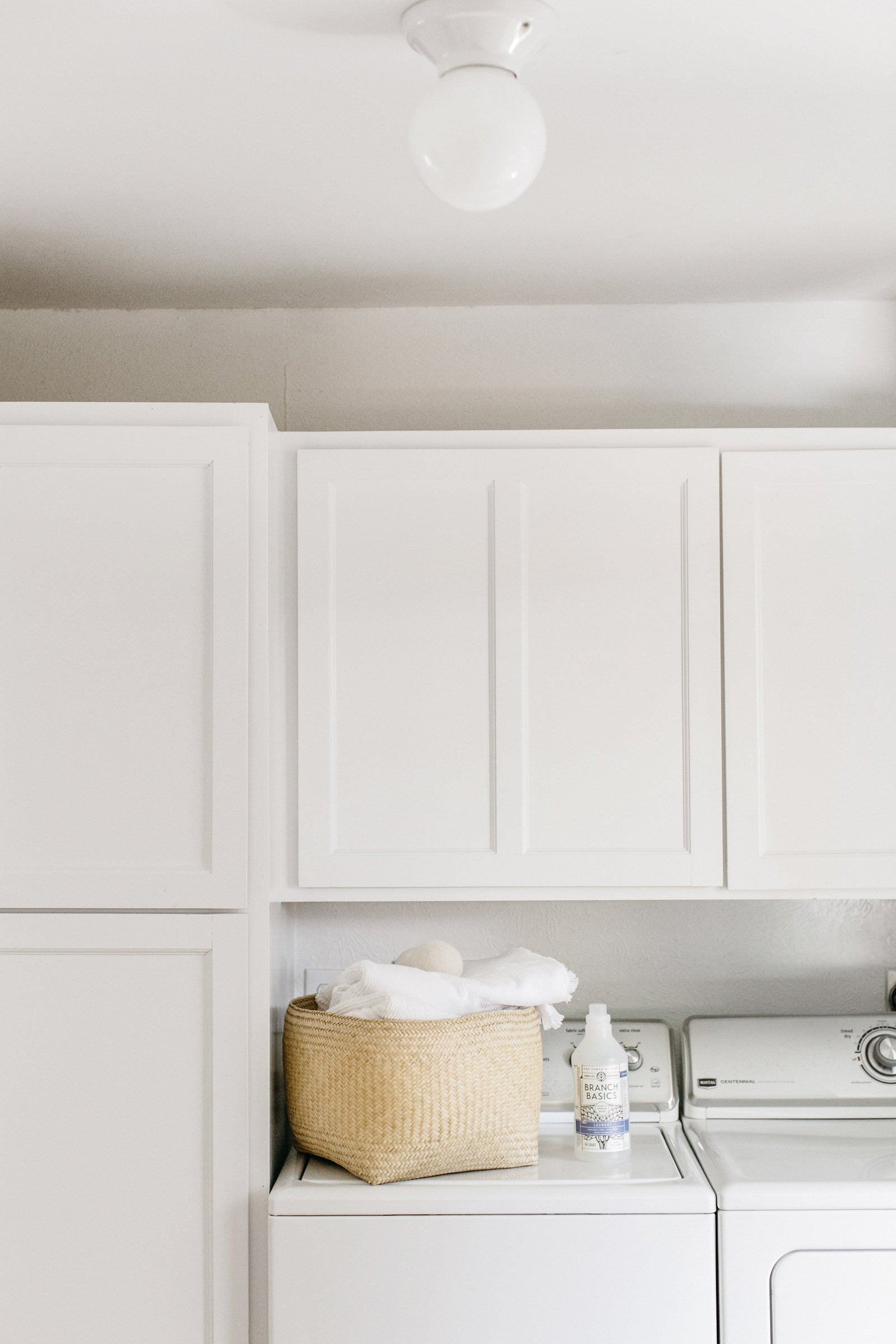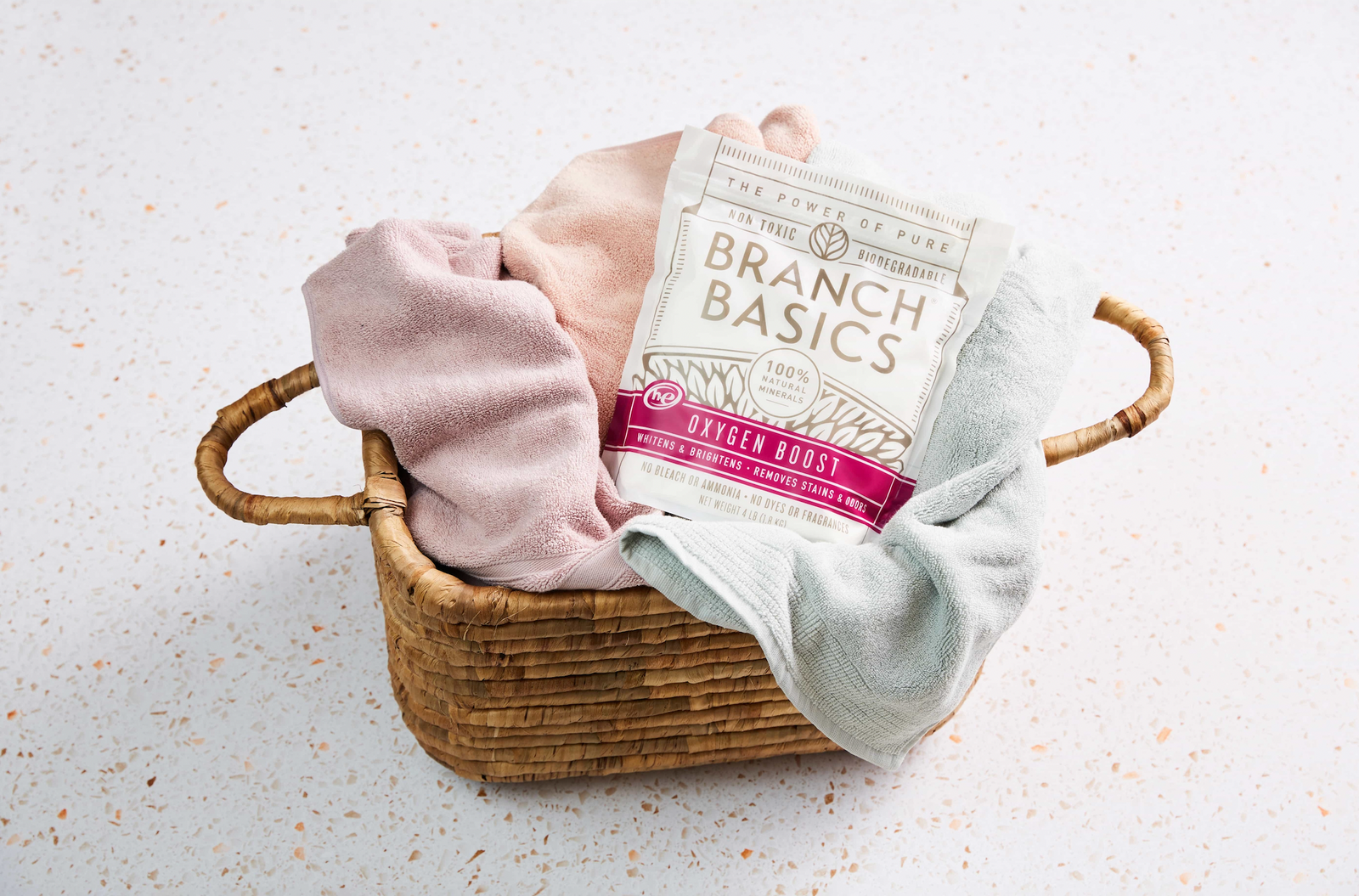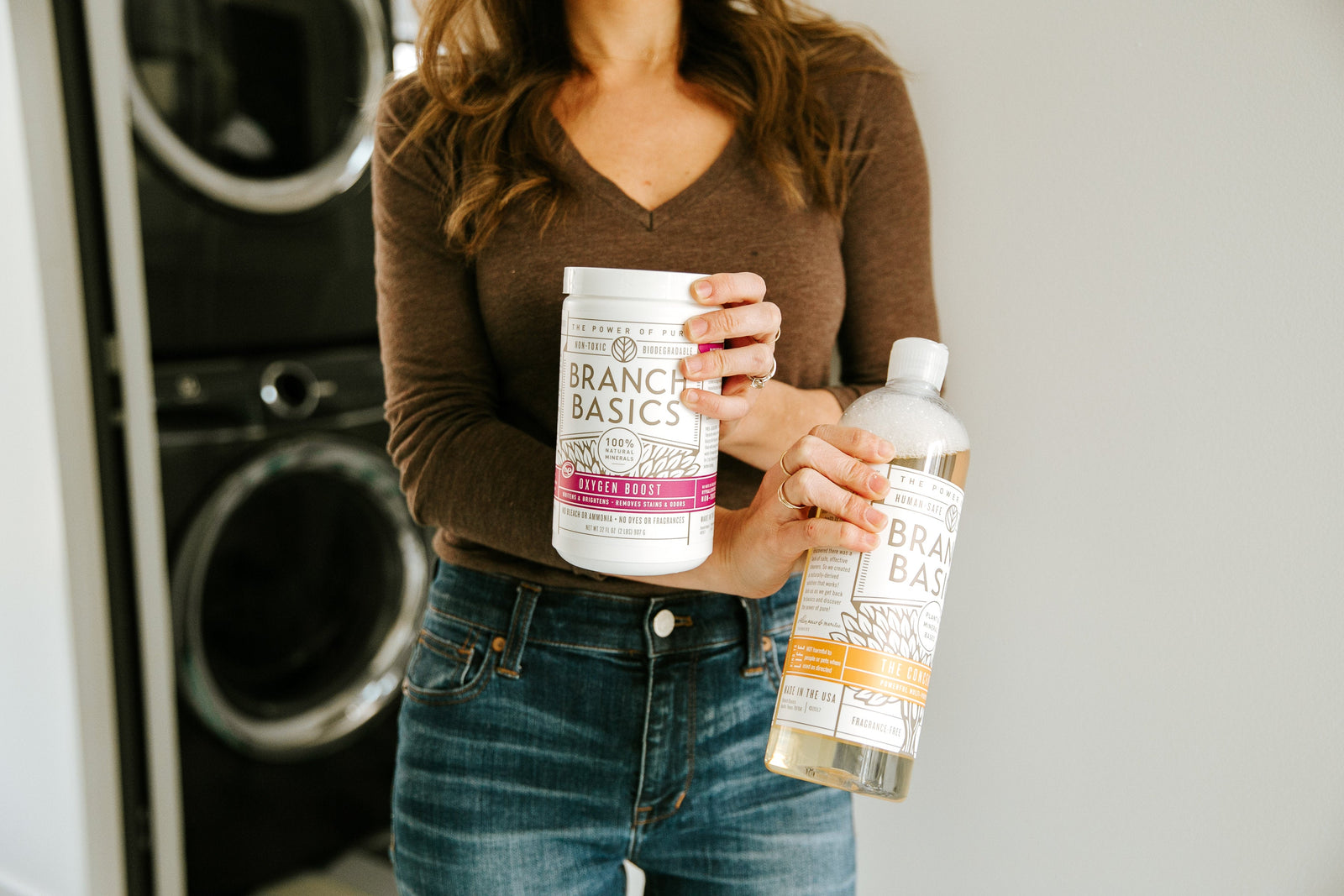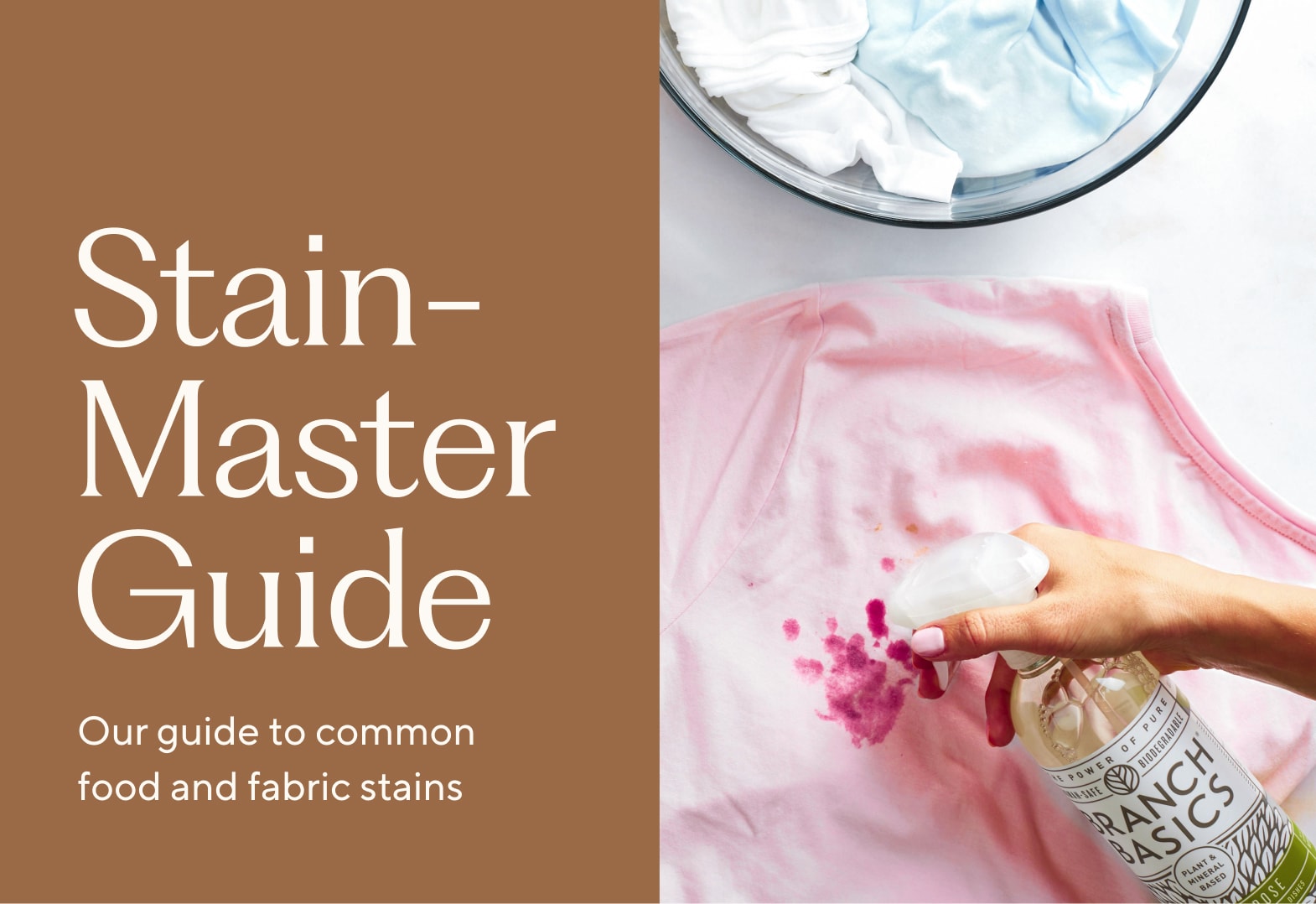5 Best Natural and Fragrance-Free Laundry Detergents

Are you looking for the best fragrance-free laundry detergent that’s also safe for babies, sensitive skin, and the chemically sensitive?
It can be a daunting task, especially given the misleading labels on many popular brands.
But don't worry! As healthy home experts with decades of combined experience in label-reading, formulating human-safe products, and working with chemically sensitive clients, we’ve got you covered with our top five best natural fragrance-free laundry detergents plus DIY options.
Dangers of Fragranced Laundry Detergents
We have always said that the laundry room is typically the most toxic room in the home.
This is due to the low-grade chemical soup of synthetic ingredients found in common laundry detergents, stain removers, laundry boosters, fabric softeners, and dryer sheets.
According to research, over 34% of the US population has a fragrance sensitivity, and over 50% of the population would prefer fragrance-free workplaces and public spaces.
These household synthetic chemicals are some of the most heinous because:
- They degrade our home’s air quality by releasing fragrance and harmful VOCs
- They pollute our waterways
- Signature fragrances can contain dozens to hundreds of undisclosed synthetic chemicals, many of which are endocrine-disruptors and neurotoxins linked to cancers, hormonal imbalances, obesity, metabolic disorders, asthma, brain disorders, and developmental issues
- Fragrance-free synthetic laundry detergents are often exactly the same formulas as their fragranced cousins but with additional synthetic fragrance-masking chemicals added!
- Many laundry products contain toxic bleach, which has been shown to negatively impact respiratory function and even cause reproductive ailments, such as miscarriage and preterm birth, via passive exposure
- Laundry fragrances are designed to impregnate clothing, which means we are breathing them in when we’re sleeping on sheets, drying off with a towel, and wearing clothes 24/7
- They’re extremely toxic and responsible for thousands of poisonings a year, especially in pets and babies who may find laundry pods irresistible to play with or ingest
- Synthetic surfactants found in laundry detergents, such as Nonylphenol Ethoxylates (NPEs), which are banned in other countries, have been linked to neurologic, immune, cardiac, kidney, and liver function ailments. They’re also highly toxic to aquatic life.
In addition, fragrance exposure has been linked to various symptoms, including:
- Contact dermatitis
- Headaches
- Respiratory issues
- Worsening asthma
- Digestive health issues
- Neurological problems
- Health problems among autistic adults
- and more
These are just a few of the dangers associated with the use of fragranced synthetic laundry detergents.
You can learn more in: Fragrance Is The New Secondhand Smoke.
Next, we’ll look a little deeper into specific ingredients to avoid.
Ingredients to Avoid in Fragrance-Free Laundry Detergents
The laundry products industry has done an excellent job of making synthetic fragrance-free laundry detergents appear safer, more sustainable, and more natural.
Unfortunately, this is typically not the case.
As previously mentioned, synthetic fragrance-free laundry detergents are often just the same as their fragranced cousins, with additional scent-masking chemicals added.
This means, you’re getting a potentially more harmful product, often at a higher price.
Here’s a list of some ingredients to avoid in synthetic fragrance-free laundry detergents.
- 1,4-Dioxane, also called Dioxane or Diethylene Oxide: Dioxane is a byproduct of ethoxylation, an inexpensive shortcut process companies use to produce softer, sudsier detergents. Since it is a byproduct rather than an ingredient, it doesn't have to be listed on product labels. The National Institute of Health (NIH) considers even trace amounts to be cause for concern, and the EPA has classified dioxane as a Class B possible carcinogen. Look for the following suffixes in the ingredient list to avoid dioxanes:
- Myreth, oleth, laureth, ceteareth, and any other "eth"
- PEG
- Polyethylene, polyethylene glycol, or polyoxyethylene
- Oxynol
- Sodium laureth/lauryl sulfate
- Chlorine bleach, aka sodium hypochlorite: Bleach is involved in more childhood poisonings than any other synthetic chemical, and passive exposure can lead to fertility issues, pregnancy complications, and adult and childhood illness. Plus, bleach degrades fabrics over time. Learn more in: Is Sodium Hypochlorite (Bleach) Toxic?
- Linear Alkyl Benzene Sulfonates (LAS): This is usually listed as 'anionic surfactants' on labels. LASs are one of the most common surfactants used in laundry detergents. During production, carcinogenic and reproductive toxins such as benzene are released into the environment. They also biodegrade slowly, making them an environmental hazard.
- Optical brighteners: Most laundry detergents contain optical brighteners, which leave a permanent or semi-permanent residue on the clothes that reflects light to make clothes appear brighter with more vivid colors. Many people develop skin irritation and rashes from exposure to optical brighteners.
- Nonylphenol Ethoxylates (NPEs): For reasons previously mentioned. Top retailers, including Wal-Mart, have listed NPEs as one of three synthetic chemicals they're asking suppliers to phase out.
- Phosphates: These are the main cleaning ingredients in many detergents and household cleaners. Phosphates are associated with human and environmental health problems, including nausea, diarrhea, and skin irritation. As persistent chemicals, they increase algae growth and suffocate salmon and other aquatic life, literally starving them of oxygen.
- Petroleum distillates (aka napthas): These crude-oil-derived solvents have been linked to asthma, cancer, lung damage, inflammation, and mucus membrane damage.
- Phenols: Phenol is recognized as so toxic that people who are hypersensitive to it could experience death or serious side effects at very low exposures. It is rapidly absorbed and can cause toxicity throughout the entire body, wreaking havoc on the central nervous system, heart, blood vessels, lungs, and kidneys.
- Sodium Lauryl Sulfate (SLS), Sodium Laureth Sulfate (SLES), and Ammonium Lauryl Sulfate (ALS): These are commonly used in many detergents as surfactants and emulsifiers. Thousands of studies on SLS have shown links to irritation of the skin and eyes, organ toxicity, developmental/reproductive toxicity, neurotoxicity, endocrine disruption, ecotoxicology, and biochemical or cellular changes.
If this seems like a lot of ingredients to memorize, that’s because it is!
Fortunately, resources like the Environmental Working Group’s Guide to Healthy Cleaning Database and app do the heavy lifting for you.
Just type in or scan the laundry product, and they will rate it from 1 (the safest) to 10 (the most toxic).
We recommend that all ingredients in products kept in your home be rated a 1 or 2.
We also advise people trying to heal skin conditions, hormone disruption, CIRS, or any chronic illness to avoid products used on the skin with the following ingredients that can be inflammatory (citric acid, sodium benzoate, potassium sorbate, and phenoxyethanol) even though they are rated a 1 or 2 on EWG Skin Deep.
From there, you can make the safest selection for your goals and budget.
Learn more in: 3 Tools You Need To Become Your Own Product Advocate.
5 Natural and Fragrance-Free Laundry Detergents
As you’ve just learned, not all fragrance-free laundry detergents are created equal.
That’s why it is essential to choose a fragrance-free laundry detergent that’s also natural and human-safe. Especially for those with sensitive or allergic conditions, delicate skin, or any of the health issues previously listed.
Without further ado, here are our top five recommendations.
1. Branch Basics
At Branch Basics, we have two safe and effective laundry products to choose from. Both our liquid Concentrate and Laundry Detergent have their unique benefits, and the choice ultimately comes down to personal preference. Choose the best option that works for you!
Laundry Detergent
Our Laundry Detergent powder is incredibly convenient and simple to use, requiring just one scoop per load with no additional products needed. It also performs well in cold water, saving energy and preserving fabric integrity.
To use:
- Add 3/4 scoop of powder into the detergent drawer. If there is no detergent drawer, add 3/4 scoop directly into the drum before adding laundry. For large or heavily-soiled loads, add 1 - 2 scoops. Be sure to follow your manufacturer guidelines if they recommend specific usage for powder.
Ingredients:
- Sodium Carbonate: enhances cleaning by binding to hard water elements, softening water, and optimizing pH levels. It ensures detergents penetrate fibers properly, keeping laundry whiter, brighter, and fresher. It also prolongs garment and machine life.
- Sodium Percarbonate: A powerful, human-safe laundry booster with bleaching, deodorizing, sanitizing, brightening, and cleaning capabilities. It effectively removes stains and disinfects by killing bacteria, viruses, fungi, mildew, and algae. Avoid use on silk, wool, and leather.
- Sodium Gluconate: A chelating agent that binds and removes minerals and metals from water, preventing stains and color fading. It acts as an anti-redeposition agent and preservative, inhibiting microbial growth in products.
- Decyl Glucoside and Lauryl Glucoside: Surfactants that reduce surface tension, making it easier for detergent to remove dirt and grime. They stabilize oil and water mixtures, creating stable, long-lasting foam. Decyl Glucoside forms a rich foam quickly that disappears fast, while Lauryl Glucoside has a slow, stable foaming action.
- Sodium Metasilicate: Softens water, augments stain removal, and neutralizes acidic soils. It emulsifies fats and oils, disperses protein stains, and improves the cleaning efficiency of surfactants.
- Tetraacetylethylenediamine (TAED): boosts sodium percarbonate’s stain removal, deodorizing, and whitening capacity. It enables low-temperature bleaching and cleaning, saving energy and preserving fabric.
- Protease: Enhances cleaning efficiency by breaking down protein stains, especially in cold water. It improves stain removal for substances like blood, egg, and grass. Note that it can break down silk and wool fibers, so avoid using it on these fabrics.
- Amylase: boosts cleaning efficiency by breaking down starch-based stains into smaller sugars, improving detergent performance. Without amylase, starch can bind to dirt, making the wash less effective.
- Sodium Lauryl Sulfoacetate: A surfactant that removes oil, dirt, and bacteria from fabric. It improves wetting, emulsifies oils, and acts as a foaming and dispersing agent.
- Sodium Polyitaconate or Polyitaconic acid: stabilizes surfactants, enhancing their effectiveness. It also increases foam volume and viscosity, leading to richer, more stable lather.
Laundry Solution
Our Laundry Solution uses our liquid Concentrate model, where you mix water with the Concentrate in a Laundry Solution bottle and add a scoop of our Oxygen Boost for extra cleaning power. We do recommend this product for the extremely chemically sensitive and chemically injured.
To use:
- Dilute Branch Basics Concentrate per Laundry Bottle instructions with water.
- Add 3/4 to 1 capful to your wash (depending on the type of washer) with optional Oxygen Boost (a mineral-based laundry brightener and whitener) and launder as usual.
Ingredients in the Concentrate, used to create the Laundry Solution, and the Oxygen Boost:
- Purified Water: Reverse osmosis…because the details matter!
- Decyl Glucoside: A mild, natural, vegan, plant-derived, biodegradable, human-safe, and sustainable surfactant suitable for the most delicate skin.
- Organic Chamomile Flower Extract: Considered our star ingredient, this organic flower extract has Allergen (IFRA) Certifications as a nonallergenic non-fragrance. Chamomile flower extract possesses anti-irritant, antiseptic, anti-bacterial, anti-fungal, and anti-inflammatory properties and is nourishing and soothing to the skin.
- Coco-Glucoside: A naturally derived surfactant derived from coconut. Coco glucoside is one of the most gentle cleansing agents available and is a natural alternative to the harsher cocamidopropyl betaine and sulfates. Its chemical nature and production process result in a surfactant free of synthetic impurities like ethylene oxide, and 1,4-dioxane, making it suitable for baby and pet products.
- Sodium Citrate: A plant-derived, biodegradable sodium salt that acts as a water softener. It’s also an acidity regulator and emulsifier in foods and drinks.
- Sodium Bicarbonate: Also known as baking soda.
- Sodium Phytate: A natural chelator, phytic acid is found in plant seeds and is often used commercially as a preservative due to its antioxidant properties.
Get your Branch Basics Laundry Kit (available in reusable plastic or glass) here.
2. DIY Fragrance-Free Laundry Detergent
Think you can’t make your own laundry detergent? Think again!
The truth is that human-safe laundry detergent is fairly simple to make and can be very effective at washing your clothes and removing stains.
There are several recipes you can try, many of which contain a combination of:
- Washing soda
- Natural bar soap
- Vinegar
- Baking soda
- Salt
- Borax*
As you’re searching recipes, be sure to avoid any that call for synthetic chemical-based ingredients, such as fragranced soap, fragrance crystals, or scented oxygen bleaches.
We recommend checking out this 2-ingredient recipe for HE laundry detergent from our friend Katie at WellnessMama.
*An Important Note About Borax Safety Concerns
Borax is considered a natural mineral and has been a popular ingredient in many DIY cleaners and laundry products.
We typically recommend it as a less toxic pest control product and for some tough cleaning jobs, like natural drain cleaning, human-safe laundry stripping, and remediating mold on clothing.
However, we recommend using it very sparingly and with caution due to evidence it is a respiratory irritant and skin allergen, and may negatively impact reproductive and developmental function. Plus, it is now rated D+ on EWG, which is very poor.
Many people still choose to use it and consider it a safer, greener alternative than other chemicals.
However, we do not recommend it for the very sensitive, the chemically sensitive, those with chronic illnesses, or for use around children or babies. In our opinion, its best and safest use is for less toxic pest management.
Sodium sesquicarbonate, rated a 1 on EWG Skin Deep, is a safer alternative to Borax, and found in some DIY recipes.
Therefore, we recommend searching “DIY Borax-Free Laundry Detergent” recipes.
3. Castile Soap
Liquid castile soap is one of the darlings of toxin-conscious DIYers because it is so versatile for cleaning, personal care, and (yes) laundry.
We recommend 100% pure, fragrance-free liquid castile soaps such as:
- Vermont Castile Soap
- Natural Way Organic Castile Soap
- St. Clare Castile Soap
- Carolina Castile Soap
- Cove Castile Soap
To use, check the instructions on the bottle.
Typically you’d add 1/3 to 1/2 a cup of liquid castile soap to a large load of laundry with 1/2 a cup of vinegar in the rinse cycle.
Pure castile bar soap can also be grated and added to DIY laundry detergents.
To save money, look for these products in bulk.
4. Soap Nuts
As discussed in, 5 Effective Natural Surfactants For Household Products, soap nuts are an excellent chemical-free laundry detergent alternative.
Soap nuts are naturally high in saponins, a plant compound that creates a surfactant, sudsing effect that cleans clothes and acts as a fabric softener.
Plus, since they’re nuts, they are 100% biodegradable or compostable and have zero scent or fragrance.
Soap nuts are also reusable, up to 10 times, or until their shells become discolored.
To use, place 4-5 soap nuts in a cotton bag and launder as usual.
5. Baking Soda + Vinegar or Lemon Juice
The combination of baking soda + a natural acid, like vinegar or lemon juice will clean, soften, and deodorize your clothes while doing the same plus descale your washing machine.
To use:
- Add half a cup of distilled white vinegar or lemon juice to your washing machine.
- Add 1 cup baking soda.
- Run the desired laundry cycle.
Baking soda, lemon juice, and vinegar are also excellent stain removers and bleach alternatives; vinegar is ideal for cleaning your washer, and baking soda is a wonderful natural deodorizer.
Discover more amazing uses for these pantry staples in:
Toss the Toxins With Branch Basics
Interested in trying Branch Basics as a human-safe fragrance-free laundry detergent alternative?
Here’s a recap of our two laundry options and how they work.
Laundry Solution
When you order a Branch Basics Premium Starter Kit (available in reusable plastic or glass) you’ll receive the Concentrate, Oxygen Boost (a bleach alternative, laundry booster, natural scouring agent, and so much more), and five bottles to make your own All-Purpose, Bathroom, Streak-Free, Laundry, and Foaming Wash.
This provides you with everything you need to clean and deodorize your clothes naturally along with several stain-removal options (All-Purpose, Bathroom, Oxygen Boost, Concentrate, and Laundry can all be used for various stains).
If you’re just interested in Branch Basics for laundry, our Laundry Kit (available in reusable plastic or glass) is your best bet and contains Concentrate, a Laundry bottle, and Oxygen Boost.
Once you receive your products, simply follow the instructions to mix the Concentrate with water in the Laundry bottle to create your natural, fragrance-free Laundry detergent.
Oh, and did we mention one bottle of Branch Basics Laundry Solution cleans a whopping 64 loads? Talk about a money and time saver!
Laundry Detergent
This product has passed the highest bar of safety in the industry and was thoughtfully formulated with your health in mind. It does not contain synthetic fragrance, dyes, optical brighteners, ammonia, chlorine, endocrine disruptors or 1,4-dioxane.
Just one scoop of our Laundry Detergent delivers a powerful deep clean. It excels in stain removal, odor elimination, and fabric preservation, streamlining your laundry routine.
Plus, it's good for the earth! This powder is biodegradable, septic-safe and prevents runoff. Because it performs excellently in cold water, it saves energy and protects your fabrics.
Both Branch Basics options provide a safer solution to doing laundry! Choose the option that works best for you.
For more helpful advice on tossing the toxins and synthetic fragrance in your laundry room and switching to natural laundry products, see:

Marilee Nelson
Marilee Nelson is an Environmental Toxins expert who has spent nearly 30 years advocating for the chemically-sensitive and chronically-ill. She is a Board Certified Nutritionist, Certified Bau-Biologist and Bau-Biology Inspector and specializes in Food As Medicine. She has helped thousands of families and individuals identify, heal and recover from toxic exposures and is on a mission to revolutionize the way American families view their health.








